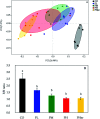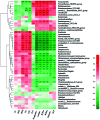Effects of dietary intake of potatoes on body weight gain, satiety-related hormones, and gut microbiota in healthy rats
- PMID: 35529109
- PMCID: PMC9073283
- DOI: 10.1039/c9ra04867g
Effects of dietary intake of potatoes on body weight gain, satiety-related hormones, and gut microbiota in healthy rats
Abstract
Potatoes, as a prominent staple food, have exerted diverse intestinal health benefits, but few studies have addressed the gut microecology modulatory effects of consuming potatoes in realistic quantities. The objective of this study was to evaluate the effects of ingesting potatoes in different doses on body weight gain (BWG), food intake, short chain fatty acids (SCFAs), fecal microbiota, gut hormones, and colon morphology of healthy rats. Male Sprague-Dawley rats of 6-8 weeks old were randomized to five groups and fed AIN-93 G or diets containing graded concentrations of potato powder (low, medium, high, and higher) for 7 weeks. Accordingly, the final body weight was significantly lower for rats fed the high and/or higher potato diets than their control counterparts (P < 0.05). Potato intervention caused a significant dose-dependent increment in full cecum, and SCFAs production. The relative abundance of "S24-7" (order Bacteroidales), Bifidobacterium, "NK3B31" (family Prevotellaceae), Parasutterella, and Ruminococcus_1 increased in high and higher potato diets. Furthermore, a Spearman's correlation analysis revealed that Parasutterella was negatively correlated with BWG, triglyceride (TG), and low-density lipoproteins (LDL). The maximum number of goblet cells, longest crypt depth, and highest level of PYY were found in the distal colon of rats fed higher potato diets. The results suggested that potato powder could provide the potential for hopeful impact on weight control.
This journal is © The Royal Society of Chemistry.
Conflict of interest statement
There are no conflicts of interest to declare.
Figures





References
-
- Ezekiel R. Singh N. Sharma S. Kaur A. Food Res. Int. 2013;50:487–496. doi: 10.1016/j.foodres.2011.04.025. - DOI
-
- Kaur L. and Singh J., Advances in Potato Chemistry and Technology, Academic Press, London, 1st edn, 2009
-
- FAOSTAT, http://faostat.fao.org, accessed 20th March, 2019
-
- Zhang H. Xu F. Wu Y. Hu H.-h. Dai X.-f. J. Integr. Agric. 2017;16:2924–2932. doi: 10.1016/S2095-3119(17)61736-2. - DOI
LinkOut - more resources
Full Text Sources
Other Literature Sources
Miscellaneous

